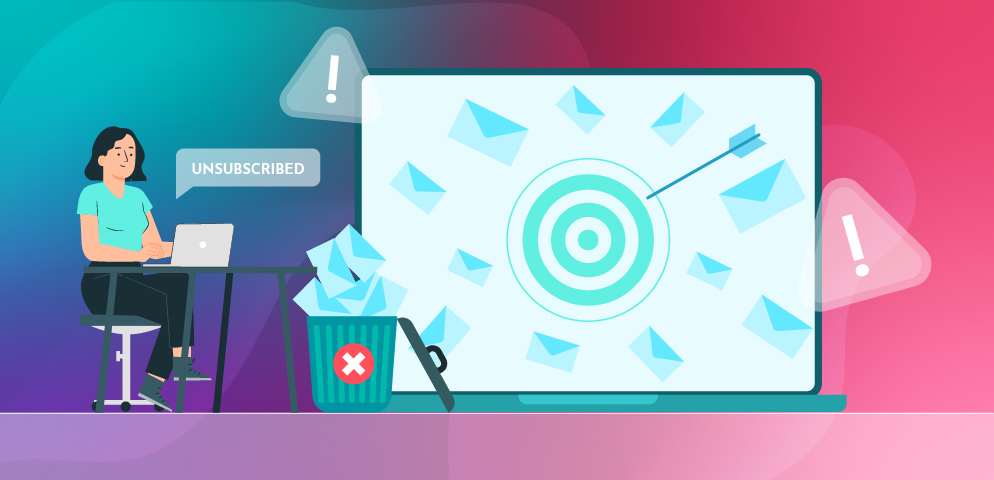
Reasons for Lower Effectiveness of your Email Marketing Campaigns (Common pitfalls and how to avoid them)
A well planned email can move your audience deeper into the sales funnel and turn them into subscribers. But when it comes to an email, overlooking the subject line, or mobile optimisation, segmentation, or GDPR rules could lead you to a low click through rate, which is the last thing you want.
Emails can be informational or commercial. Informational emails rely heavily on content marketing, and are conducted by companies with content marketing teams, who create regular and high quality content to keep their subscribers engaged. Commercial or promotional emails are where marketers obtain a list of contacts who have opted-in to receive business or marketing messages like promotional offers etc, rather than newsletters or content.
Here are some common mistakes made by a lot of marketers while sending commercial emails, that may lead to a low open rate, or dissatisfaction with the email content or frequency, resulting in a high unsubscribe rate, making the campaign ineffective.
Having an inappropriate subject line, like ones that are exaggerated or have clickbait are the main reason why recipients report marking emails as spam. Such subject lines can be misleading or create high expectations which are not met in the rest of the email.
Almost 50% of email recipients open an email simply based on the subject line alone. Moreover, around 69% of email recipients also report emails as spam solely based on the subject line.
Therefore it is very important to personalise the email, avoid yelling at the readers by using all caps, keep the subject line professional, avoid hyped-up words, rather keep it crisp and simple.
The next reason for low effectiveness is not segmenting the contacts on your list. Segmentation is necessary so you don’t have to send the same email to all of your subscribers. Categories like geography, demographics, psychographic factors and behaviour are some broad categories for segmentation. This will ensure your emails are relevant to your subscribers.
A third reason for low email effectiveness is neglecting GDPR considerations.
The GDPR laws that came into effect in late May 2018, have entirely changed the world of email marketing. GDPR standards make it obligatory for businesses to show proof that customers have opted in to receive marketing emails. These rules are mainly applicable to Europe, but countries all over the world have some form of equivalent data protection and privacy laws.
Following the GDPR, businesses must show proof that customers have opted in to receive marketing emails. By obtaining consent through single or double opt-in methods, companies can abide by these regulations, and still have successful email campaigns.
Another mistake is failing to look professional. Most readers are rightfully sceptical of new websites and emails until they’re proven safe and professional. Spelling and grammar are the first points to consider. Instead of attaching a pdf, it’s better to add a link to download the pdf, if the user wants to. Unless your attachment is a pdf the reader specifically signed up to receive. Avoid keeping the language too casual. Avoid using cliche and sales heavy language, while making sure it’s not very formal at the same time. The language has to be the right balance between professional and personal.
Lastly, a mistake usually made is not optimising for mobile users, More than 50% of your readers will be reading your email on their mobile devices. If your email contains images, make sure the formatting for mobile devices is simple and clean, with images and text that are easily readable on a small screen, since mobile screens offer you very minimal real estate. So the text should have a readable size; the images, if any are clear, and there’s enough of white space. Many readers may view emails with images turned off, so it’s not a good idea to rely too heavily on them.
Keeping these rules in mind, will help marketers achieve higher effectiveness on their email campaigns, by increasing the chances of users opening their emails, and also make them less likely to unsubscribe.
Ascentrik Growth Story 2022 2023
B2B Data validation and enrichment is the practice of refining your existing CRM database by eliminating redundant and unwanted contact information and appending additional data points to your prospects’ records like phone numbers, industry, size of the company, designation, etc. It is one of the most beneficial practices for both your marketing and sales teams.
Refreshing your email list can be seen as an ongoing process during your marketing campaigns, as it allows you to source highly qualified leads, which enables targeting the right person with the right message. It can help your sales team with customer segmentation and lead scoring, allowing them to create personas for your prospects and craft a personalised sales pitch, improving the chances of converting them into customers.
But what is the most profitable method to get this highly valuable task done? Is it software tools for automated data enrichment or tools enhanced with data research by a team of experts? Find out the benefits of both in the article below.
How Contact Data Enrichment helps in converting more Leads
Customised contact and company data enrichment for niche targets, using automation and a team of researchers
How much does it cost to buy a b2b email list or email database?
[dsm_perspective_image src="https://www.ascentrik.com/wp-content/uploads/2023/04/blog-feb-2023.jpg" alt="cost of email databases" title_text="Buy b2b email list" align="center" force_fullwidth="on" _builder_version="4.24.0" _module_preset="default" width="80%"...


